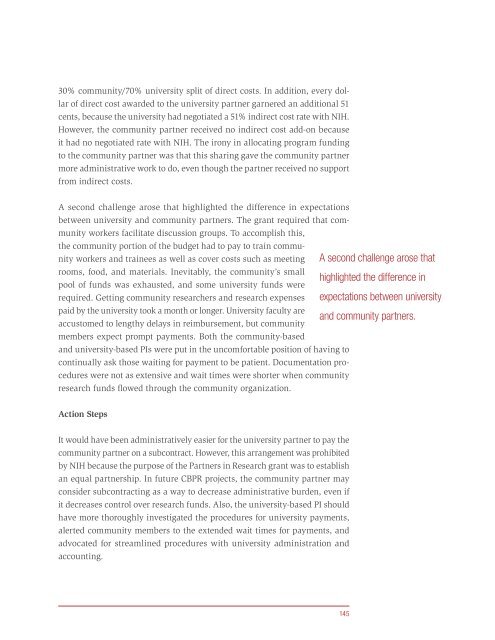Principles of Community Engagement (Second Edition)
Principles of Community Engagement (Second Edition)
Principles of Community Engagement (Second Edition)
You also want an ePaper? Increase the reach of your titles
YUMPU automatically turns print PDFs into web optimized ePapers that Google loves.
30% community/70% university split <strong>of</strong> direct costs In addition, every dol-<br />
lar <strong>of</strong> direct cost awarded to the university partner garnered an additional 51<br />
cents, because the university had negotiated a 51% indirect cost rate with NIH<br />
However, the community partner received no indirect cost add-on because<br />
it had no negotiated rate with NIH The irony in allocating program funding<br />
to the community partner was that this sharing gave the community partner<br />
more administrative work to do, even though the partner received no support<br />
from indirect costs<br />
A second challenge arose that highlighted the difference in expectations<br />
between university and community partners The grant required that community<br />
workers facilitate discussion groups To accomplish this,<br />
the community portion <strong>of</strong> the budget had to pay to train community<br />
workers and trainees as well as cover costs such as meeting<br />
rooms, food, and materials Inevitably, the community’s small<br />
pool <strong>of</strong> funds was exhausted, and some university funds were<br />
required Getting community researchers and research expenses<br />
paid by the university took a month or longer University faculty are<br />
accustomed to lengthy delays in reimbursement, but community<br />
members expect prompt payments Both the community-based<br />
and university-based PIs were put in the uncomfortable position <strong>of</strong> having to<br />
continually ask those waiting for payment to be patient Documentation procedures<br />
were not as extensive and wait times were shorter when community<br />
research funds flowed through the community organization<br />
Action Steps<br />
It would have been administratively easier for the university partner to pay the<br />
community partner on a subcontract However, this arrangement was prohibited<br />
by NIH because the purpose <strong>of</strong> the Partners in Research grant was to establish<br />
an equal partnership In future CBPR projects, the community partner may<br />
consider subcontracting as a way to decrease administrative burden, even if<br />
it decreases control over research funds Also, the university-based PI should<br />
have more thoroughly investigated the procedures for university payments,<br />
alerted community members to the extended wait times for payments, and<br />
advocated for streamlined procedures with university administration and<br />
accounting<br />
A second challenge arose that<br />
highlighted the difference in<br />
expectations between university<br />
and community partners.<br />
145

















